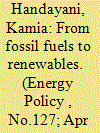|
|
|
Sort Order |
|
|
|
Items / Page
|
|
|
|
|
|
|
| Srl | Item |
| 1 |
ID:
186495


|
|
|
|
|
| Summary/Abstract |
Learning curve theory has been adopted for investigating the relationship between technological learning and technology cost developments. The aim of this paper is to explore the impacts of public investment in clean energy research, development, and demonstration (RD&D) on future technology cost developments by using a two-factor learning curve approach. Learning-by-deploying and learning-by-researching were chosen as the main sources of learning. The focus is on onshore wind and solar photovoltaics in the United States of America. By using publicly available data, we estimated learning-by-deploying rates of 31.4% and 27.6%; and learning-by-researching rates of 2.3% and 4.7% for onshore wind and solar PV, respectively. By adopting a logistic curve approach, an additional $1322 and $819 mil. were forecast to be spent by 2050 in RD&D for onshore wind and solar PV, respectively. We explored the plausible long-term effects of diverse RD&D investment scenarios on electricity generation and greenhouse gas (GHG) emissions using a system dynamics model. The findings reveal that public investment in RD&D for clean energy technologies may play a key role in the pace of capital cost reductions and technology diffusion. However, relatively little long-term effects of RD&D efforts alone were found on market dynamics and GHG emissions.
|
|
|
|
|
|
|
|
|
|
|
|
|
|
|
|
| 2 |
ID:
162267


|
|
|
|
|
| Summary/Abstract |
For a long time hydrogen has been considered a clean energy carrier to be applied universally and contribute to a sustainable energy system. However, in the real energy world hydrogen has not yet delivered. The major reason is that it has still to become economically feasible. With increasing electricity generation from variable renewables and its temporarily cheap surplus production, new prospects for hydrogen are on the horizon especially due to the rising need for a solution to the problem of the long-term storage of excess electricity.
|
|
|
|
|
|
|
|
|
|
|
|
|
|
|
|
| 3 |
ID:
052293


|
|
|
|
|
| Publication |
Oct 2004.
|
| Summary/Abstract |
This paper presents the results of using a stylized optimization model of the global electricity supply system to analyze the optimal research and development (R&D) support for an energy technology. The model takes into account the dynamics of technological progress as described by a so-called two-factor learning curve (2FLC). The two factors are cumulative experience ("learning by doing") and accumulated knowledge ("learning by searching"); the formulation is a straightforward expansion of conventional one-factor learning curves, in which only cumulative experience is included as a factor, which aggregates the effects of accumulated knowledge and cumulative experience, among others. The responsiveness of technological progress to the two factors is quantified using learning parameters, which are estimated using empirical data. Sensitivities of the model results to the parameters are also tested. The model results also address the effect of competition between technologies and of CO2 constraints. The results are mainly methodological; one of the most interesting is that, at least up to a point, competition between technologies-in terms of both market share and R&D support-need not lead to "lock-in" or "crowding-out".
|
|
|
|
|
|
|
|
|
|
|
|
|
|
|
|
| 4 |
ID:
166341


|
|
|
|
|
| Summary/Abstract |
This study analyses a diffusion of renewable energy in an electricity system accounting for technological learning. We explore long-term scenarios for capacity expansion of the Java-Bali electricity system in Indonesia, considering the country’s renewable energy targets. We apply the Long-range Energy Alternative Planning (LEAP) model with an integration of technological learning. Our results reveal that, at the medium and high pace of technological learning, the total costs of electricity production to achieve the long-term renewable energy target are 4–10% lower than the scenario without considering technological learning. With respect to technology, solar PV and wind become competitive with other types of renewables and nuclear. Moreover, the fulfilment of the renewable energy targets decreases CO2 emissions by 25% compared to the reference scenario. Implications of our results indicate that energy policies should focus on the early deployment of renewables, upgrading the grid capacity to accommodate variable renewable energy, and enabling faster local learning.
|
|
|
|
|
|
|
|
|
|
|
|
|
|
|
|
| 5 |
ID:
167026


|
|
|
|
|
| Summary/Abstract |
While the role of organizational learning in improving firm performance is well documented, there are still questions on what drives technological learning. This is evident in the electricity industry where the growth of renewable energy technologies has been pervasive. Vicarious learning contributes to the adoption of emerging technologies through successful inter-firm knowledge sharing and transfer. However, there is hesitation to adoption that characterizes vicarious learning especially in the context of intra-firm learning. This paper investigates the differences in knowledge acquisition within and across electricity firms in the U.S. The learning curve model is applied to a longitudinal study of 5573 plants belonging to 1542 U.S. electricity firms between 1998 and 2010. This study finds: (i) The capacity growth of the solar photovoltaic technology is positively associated with intra-firm knowledge acquisition; (ii) The effect of financial incentives on the adoption of solar and wind technologies is higher under inter-firm learning; (iii) The higher the stringency of policy mandates, the more varied is the progress on technological change across technologies; (iv) Knowledge sharing between firms are higher for wind technology than for solar technology. These findings combine to show disparities in the learning trends of technologies across and within firms’ boundaries.
|
|
|
|
|
|
|
|
|
|
|
|
|
|
|
|
| 6 |
ID:
108129


|
|
|
|
|
| Publication |
2011.
|
| Summary/Abstract |
This paper provides an analysis of the relative significance of various methods of acquiring tacit knowledge within the Chinese optical fibre and cable industry. The paper contributes to the definition, understanding and investigation of tacit knowledge using firm-level data in a developing country context, helping to complete a gap in the existing broader literature on technological learning. The research suggests that in industries where tacit knowledge is a more important component of technological learning than codified knowledge, internal R&D activities and domestic peers are important knowledge sources. Additionally, universities are shown to be an important asset in creating learning organisations and provide effective knowledge sources of both tacit and codified knowledge. However, imports of equipment and licensing are a less effective learning channel in the acquisition of tacit foreign technology.
|
|
|
|
|
|
|
|
|
|
|
|
|
|
|
|
| 7 |
ID:
088964


|
|
|
|
|
| Publication |
2009.
|
| Summary/Abstract |
High costs often prevent the market diffusion of novel and efficient energy technologies. Monitoring cost and price decline for these technologies is thus important in order to establish effective energy policy. Here, we present experience curves and cost-benefit analyses for condensing gas boilers produced and sold in the Netherlands between 1981 and 2006. For the most dominant boiler type on the Dutch market, i.e., condensing gas combi boilers, we identify learning rates of 14±1% for the average price and 16±8% for the additional price relative to non-condensing devices. Economies of scale, competitive sourcing of boiler components, and improvements in boiler assembly are among the main drivers behind the observed price decline. The net present value of condensing gas combi boilers shows an overall increasing trend. Purchasing in 2006 a gas boiler of this type instead of a non-condensing device generates a net present value of 970 EUR (Euro) and realizes CO2 (carbon dioxide) emission savings at negative costs of ?120 EUR per tonne CO2. We attribute two-thirds of the improvements in the cost-benefit performance of condensing gas combi boilers to technological learning and one-third to a combination of external effects and governmental policies
|
|
|
|
|
|
|
|
|
|
|
|
|
|
|
|
| 8 |
ID:
115137


|
|
|
|
|
| Publication |
2012.
|
| Summary/Abstract |
Hybrid-electric vehicles (HEVs) and battery-electric vehicles (BEVs) are currently more expensive than conventional passenger cars but may become cheaper due to technological learning. Here, we obtain insight into the prospects of future price decline by establishing ex-post learning rates for HEVs and ex-ante price forecasts for HEVs and BEVs. Since 1997, HEVs have shown a robust decline in their price and price differential at learning rates of 7±2% and 23±5%, respectively. By 2010, HEVs were only 31±22 €2010 kW-1 more expensive than conventional cars. Mass-produced BEVs are currently introduced into the market at prices of 479±171 €2010 kW-1, which is 285±213 €2010 kW-1 and 316±209 €2010 kW-1 more expensive than HEVs and conventional cars. Our forecast suggests that price breakeven with these vehicles may only be achieved by 2026 and 2032, when 50 and 80 million BEVs, respectively, would have been produced worldwide. We estimate that BEVs may require until then global learning investments of 100-150 billion € which is less than the global subsidies for fossil fuel consumption paid in 2009. These findings suggest that HEVs, including plug-in HEVs, could become the dominant vehicle technology in the next two decades, while BEVs may require long-term policy support.
|
|
|
|
|
|
|
|
|
|
|
|
|
|
|
|
|
|
|
|
|